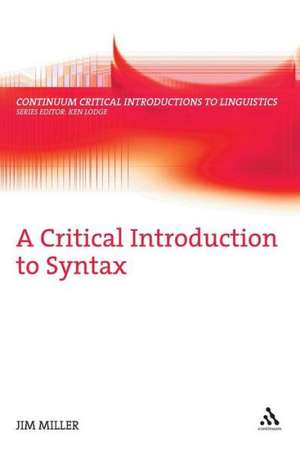A Critical Introduction to Syntax: Bloomsbury Critical Introductions to Linguistics
Autor Professor Jim Milleren Limba Engleză Paperback – 12 ian 2011
| Toate formatele și edițiile | Preț | Express |
|---|---|---|
| Paperback (1) | 265.47 lei 6-8 săpt. | |
| Bloomsbury Publishing – 12 ian 2011 | 265.47 lei 6-8 săpt. | |
| Hardback (1) | 1008.43 lei 6-8 săpt. | |
| Bloomsbury Publishing – 12 ian 2011 | 1008.43 lei 6-8 săpt. |
Preț: 265.47 lei
Preț vechi: 303.65 lei
-13% Nou
Puncte Express: 398
Preț estimativ în valută:
50.80€ • 52.84$ • 41.94£
50.80€ • 52.84$ • 41.94£
Carte tipărită la comandă
Livrare economică 15-29 aprilie
Preluare comenzi: 021 569.72.76
Specificații
ISBN-13: 9780826497048
ISBN-10: 0826497047
Pagini: 288
Dimensiuni: 156 x 234 x 18 mm
Greutate: 0.43 kg
Editura: Bloomsbury Publishing
Colecția Continuum
Seria Bloomsbury Critical Introductions to Linguistics
Locul publicării:London, United Kingdom
ISBN-10: 0826497047
Pagini: 288
Dimensiuni: 156 x 234 x 18 mm
Greutate: 0.43 kg
Editura: Bloomsbury Publishing
Colecția Continuum
Seria Bloomsbury Critical Introductions to Linguistics
Locul publicării:London, United Kingdom
Caracteristici
Describes grammar and meaning as being closely connected -- that all grammatical morphemes carry meaning.
Notă biografică
Jim Miller is Professor Emeritus at the University of Edinburgh (formerly Professor of Linguistics and Spoken Language at Edinburgh and Professor of Cognitive Linguistics at the University of Auckland, New Zealand).
Cuprins
Introduction and Acknowledgments \ 1. Theory, Data and Analysis \ 2. Dependency Relations \ 3. Configurationality \ 4. Constructions \ 5. Grammaticality \ 6. Usage-based analysis \ 7. Grammar and Semantics: the get passive \ 8. Grammar and \ Semantics: wh words \ 9. Grammar and Semantics: parts-of-speech \ 10. Grammar and Semantics: thematic roles11. Language Complexity \ 12. First Language Acquisition \ Epilogue \ Bibliography \ Index
Recenzii
An exploration of the syntax of real language, both spoken and written, which unearths fascinating examples, showing just how different the two can be -- and how challenging they are for linguists of different persuasions.


















